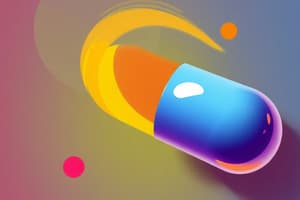Podcast
Questions and Answers
What does biopharmaceutics involve?
What does biopharmaceutics involve?
- The delivery of drug to the site of action (correct)
- The storage of the drug product
- The design of the drug product (correct)
- The taste of the drug product
Pharmacodynamics refers to what the drug does to the body.
Pharmacodynamics refers to what the drug does to the body.
True (A)
What is bioavailability?
What is bioavailability?
The measurement of the rate and extent of active drug that reaches the systemic circulation.
Pharmacokinetics is the science of the kinetics of drug _____, distribution, and elimination.
Pharmacokinetics is the science of the kinetics of drug _____, distribution, and elimination.
Which of the following describes toxicokinetics?
Which of the following describes toxicokinetics?
What is the focus of clinical toxicology?
What is the focus of clinical toxicology?
Match the following terms with their definitions:
Match the following terms with their definitions:
What does biopharmaceutics involve?
What does biopharmaceutics involve?
What is pharmacodynamics?
What is pharmacodynamics?
The measurement of the rate and extent of active drug reaching the systemic circulation is known as _____
The measurement of the rate and extent of active drug reaching the systemic circulation is known as _____
Toxicokinetics is unrelated to the design and interpretation of drug safety evaluation studies.
Toxicokinetics is unrelated to the design and interpretation of drug safety evaluation studies.
What does a drug product facilitate?
What does a drug product facilitate?
Which of the following dosage forms can drugs be given in?
Which of the following dosage forms can drugs be given in?
What does clinical toxicology study?
What does clinical toxicology study?
Flashcards are hidden until you start studying
Study Notes
Biopharmaceutics
- Biopharmaceutics studies factors that influence the behavior of drugs in the body, specifically their formulation, stability, manufacture, and effectiveness.
- Key aspects analyzed include drug product design, stability, manufacturing processes, and drug release mechanisms.
- Focus on the interaction between the drug's physical and chemical properties, the formulation, and the administration route affects systemic drug absorption.
- Delivery methods can target localized effects or facilitate systemic absorption.
Introduction
- Drugs are defined as substances for diagnosing, curing, mitigating, treating, or preventing diseases.
- They come in various dosage forms: solids (tablets, capsules), semisolids, liquids, suspensions, and emulsions, suitable for systemic or local activity.
- Drug products serve as delivery systems that release the drug, ensuring therapeutic effects while considering patient needs like palatability and safety.
Drug Product Performance
- Drug release from products is essential for achieving local action or systemic therapeutic levels.
- Bioavailability, a critical concept, indicates the rate and extent of active drug reaching systemic circulation, reflecting its effectiveness.
Pharmacodynamics
- Studies the relationship between drug concentration at the target site (receptor) and pharmacologic responses, including biochemical and physiological effects.
- Describes the effects drugs produce in the body, emphasizing the mechanisms behind these effects.
Toxicokinetics
- Involves applying pharmacokinetic principles to evaluate drug safety through dose-related exposure studies in animals.
Clinical Toxicology
- Focuses on adverse effects produced by drugs and toxic substances (poisons) on the body.
Pharmacokinetics
- Concerned with the kinetics of drug absorption, distribution, metabolism, and excretion.
- Aims to understand how drugs move through the body and are eliminated, contributing to the overall pharmacodynamic process.
Bioavailability
- Measures the rate and extent to which an active drug reaches systemic circulation, indicating its therapeutic potential and effectiveness.
Biopharmaceutics
- Biopharmaceutics studies factors that influence the behavior of drugs in the body, specifically their formulation, stability, manufacture, and effectiveness.
- Key aspects analyzed include drug product design, stability, manufacturing processes, and drug release mechanisms.
- Focus on the interaction between the drug's physical and chemical properties, the formulation, and the administration route affects systemic drug absorption.
- Delivery methods can target localized effects or facilitate systemic absorption.
Introduction
- Drugs are defined as substances for diagnosing, curing, mitigating, treating, or preventing diseases.
- They come in various dosage forms: solids (tablets, capsules), semisolids, liquids, suspensions, and emulsions, suitable for systemic or local activity.
- Drug products serve as delivery systems that release the drug, ensuring therapeutic effects while considering patient needs like palatability and safety.
Drug Product Performance
- Drug release from products is essential for achieving local action or systemic therapeutic levels.
- Bioavailability, a critical concept, indicates the rate and extent of active drug reaching systemic circulation, reflecting its effectiveness.
Pharmacodynamics
- Studies the relationship between drug concentration at the target site (receptor) and pharmacologic responses, including biochemical and physiological effects.
- Describes the effects drugs produce in the body, emphasizing the mechanisms behind these effects.
Toxicokinetics
- Involves applying pharmacokinetic principles to evaluate drug safety through dose-related exposure studies in animals.
Clinical Toxicology
- Focuses on adverse effects produced by drugs and toxic substances (poisons) on the body.
Pharmacokinetics
- Concerned with the kinetics of drug absorption, distribution, metabolism, and excretion.
- Aims to understand how drugs move through the body and are eliminated, contributing to the overall pharmacodynamic process.
Bioavailability
- Measures the rate and extent to which an active drug reaches systemic circulation, indicating its therapeutic potential and effectiveness.
Studying That Suits You
Use AI to generate personalized quizzes and flashcards to suit your learning preferences.




